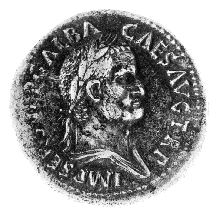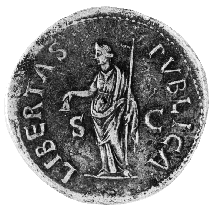



(80) Galba - AE sestertius, A.D. 69, 26.27 g. (inv. 91.143).
Obverse: Draped and laureate bust of Galba r.; IMP(ERATOR) SER(VIVS) SVLP(ICIVS)
GALBA CAES(AR) AVG(VSTVS) TR(IBVNICIA) P(OTESTATE): Imperator
Servius Sulpicius Galba, Caesar, Augustus, with tribunician power.
Reverse: Libertas standing l., draped and holding pileus in r. and
scepter in l.; LIBERTAS PVBLICA: Liberty of the public; S(ENATVS)-C(ONSVLTO):
by decree of the Senate.
Provenance: Coin Galleries, 1960.
Bibliography: C.H.V. Sutherland, The Roman Imperial Coinage I: from 31
BC to AD 69, rev. ed. (London 1984) 309.
Servius Sulpicius Galba, who was born into an old aristocratic family and
who had served as governor in Germany and Spain, joined the revolt against
Nero, was hailed imperator by his troops, and assumed the title Augustus
on the death of Nero. He was murdered by his troops after a reign of only
about eight months.
Galba issued coins during the revolt, before he had been confirmed as Augustus
by the Senate, and these featured types and slogans of the revolt promising
the restitution of Rome and of liberty. This coin, issued after Galba had
become emperor, still has some of that character, with its reverse depicting
Libertas Publica. Libertas had been worshipped in the republic as the personification
of personal liberty, but in the empire she stood for liberation from tyranny.
Here she holds her usual attributes, a scepter and a pileus, a conical
cap given to slaves when they received their freedom.
Galba's portrait on the obverse shows that he rejected the youthful classicism
of the Julio-Claudians and the flourishes of Nero for an uncompromising
realism perhaps meant to recall the verism of the late republic and to appeal
to the military upon which his power depended. He was already over seventy
when he became emperor, and he is depicted as elderly, with a lined forehead,
bags under his eyes, and sagging jowls.
C.L.L.



All contents copyright (c) 1996.
Lawrence University
All rights reserved.